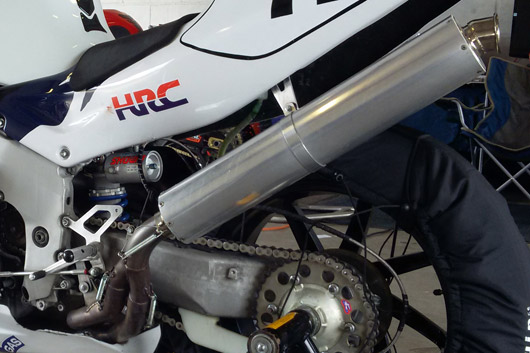Force-V4 Menu
RVF750-RC45 Exhaust Tuning
The very first system that needs to be upgraded from the standard setup is the exhaust. In the RC45’s case there are many ways of doing this, and careful consideration must be taken in deciding which option should be chosen.
RC45 Race Silencers
The first option is a bolt-on race silencer. This will mount to the standard link pipe and will normally come with a new strap to allow it to be held using the standard exhaust hanging brackets.
Companies such as Quill, Yoshimura, Micron and MIG, to name but a few, have made or are still making bolt on silencers for the RC45. Each of these silencers offer very good returns for relatively low cost.
A stock RC45 will produce around 98-102 rear wheel hp once derestricted. With a race silencer this figure can grow to around 107-108rwhp. The OEM silencer is very heavy, so a reduction in weight, often quite substantial with some aftermarket silencers, is also beneficial.
RC45 Race Systems
 Yamamoto Twin-stack.
Yamamoto Twin-stack.
If you have the urge for something a little more special than just a race silencer then you will be looking at a full system. These again were made by a number of companies including HRC, Yoshimura and Micron. Fitting a full system is less than easy though!
The only full system that will fit a stock RC45 without additional modifications is the single-can Micron system. These have not been produced for a number of years but do sometimes come up for sale. These systems were made from steel with either a carbon or alloy can. They can be used with the stock body work and retain the radiator cooling fan.
Next on the list is the Yoshimura system. The most common one seen is the twin-stack system having one silencer on top of the other. This is a very good system and works well with both stock engines and lightly tuned ones. It does however have some draw backs. Although it can be fitted and retains the radiator cooling fan, its' link pipes require the fairing belly pan of a stock RC45 to be cut to allow clearance. This of course isn’t always very pleasing if the bike is stock and is in good condition. The best solution is to find second hand damaged panels to allow this modification to take place. Expect to see around 110-112rwhp with this type of system.
RC45 HRC Systems
HRC made a number of exhaust systems over the years for the RC45. These systems, while being very well made, do not work very well on stock engines and require not only the fairing to be cut to clear them, but also the removal of the radiator cooling fan. The lower radiator must also be moved forward to clear the header pipes.
 1994 HRC System.
1994 HRC System.
The first systems to be produced for the 1994 season were of a single can style. These systems had a uneven front header section and each header was bent out of a single tube. There was a choice of either an alloy or carbon can, though alloy was the most common.
The second was an update for 1995. This was basically the same exhaust but with revised can internals.
There were also two other systems made, a factory titanium system with carbon can as well as a very small number of systems with even front header lengths. The factory teams started using the first of the twin stack systems in 1995 but these were not available to the public until 1996.
1996 saw the first aftermarket sales of the HRC kit twin-stack systems. These came with even length headers and were fitted with twin alloy cans. The headers were made out of three sections of tubing welded together rather than the pervious years one-piece items.
The twin can system works very well on tuned engines and produces slightly more peak power compared to the single can system. However, they do tend to loose a little power and torque below 8000rpm. Again the fairing and radiator will need to be altered to allow this system to fit.
The last of the HRC systems were produced in 1997. This system was again a twin-stack system, but had longer rear header sections to try and improve the midrange lost by the ’96 system.
There was an HRC system produced in 1998 which used the 1997 headers but with link pipes allowing one silencer to be mounted either side of the bike. This system was never sold and is quite rare. It shares the same silencers as the twin can system and was used at the very start of the ’98 season before changing to Akrapovic.
Note: When using the Ohlins Superbike linkage its very common for all of the HRC systems to foul them.
RC45 Akrapovic Systems
 1998 HRC Akropovic system.
1998 HRC Akropovic system.
From 1998 the factory bikes started to run systems made by Akrapovic. These took the form of a single silencer up either side of the bike, like the early 1998 HRC systems. While never produced by Akrapovic for the public, a number of these have found their way on the market.
Most of these systems were made in titanium with carbon silencers, but a number were also made using stainless headers. These systems require the same modification to a stock bike as the HRC systems.